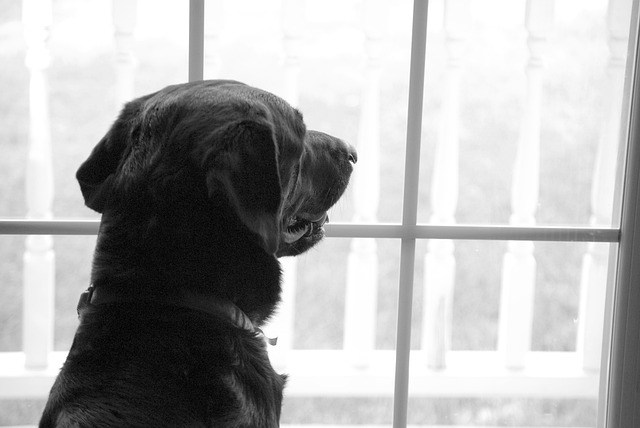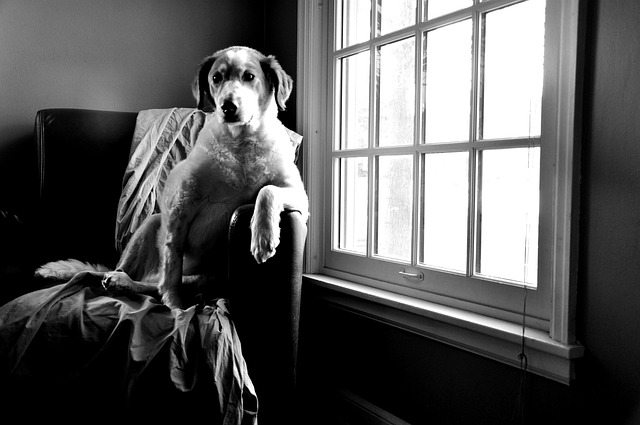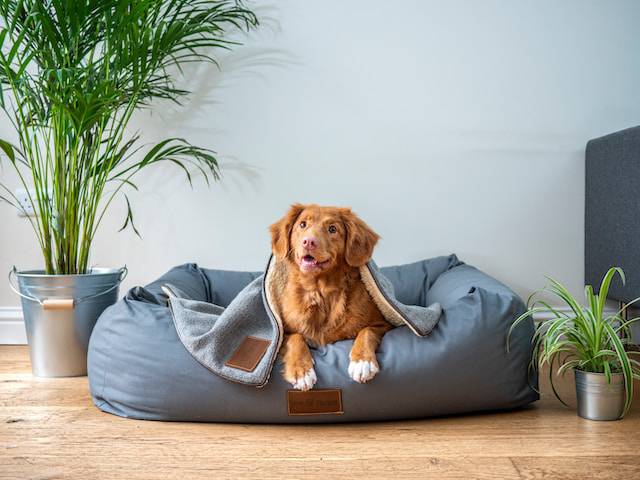Today, let’s talk about a common issue that many of our furry friends face: separation anxiety in dogs. You know that heart-wrenching feeling when you leave the house and your pup starts panicking?
Well, in this blog post, we’re going to dive deep into the causes, symptoms, and solutions for separation anxiety, so you can help your four-legged buddy feel calm and confident even when you’re not around.
So, grab a cup of coffee, and let’s get started!
What is Separation Anxiety in Dogs
Separation anxiety in dogs is a condition where dogs experience distress and anxiety when they are separated from their owners or familiar environments.
It is a common behavioral issue in dogs and can manifest through behavior issues such as excessive barking, destructive chewing, and house soiling.
Early socialization and training can help prevent or reduce separation anxiety in dogs. Gradual desensitization and counterconditioning techniques can also be used to help dogs overcome separation anxiety.
Causes of Separation Anxiety in Dogs

Separation anxiety in dogs is a condition where dogs become extremely anxious and distressed when separated from their owners.
There are several major causes of separation anxiety in dogs:
1. Lack of Socialization: Dogs that have not been properly socialized may develop separation anxiety. Socialization helps dogs become comfortable with being alone and builds their confidence.
2. Traumatic Experiences: Dogs that have experienced traumatic events while being alone, such as being frightened by storms or fireworks, may develop separation anxiety. These negative experiences can create a fear of being alone.
3. Over-Attachment: Some dogs become overly attached or dependent on their owners, leading to separation anxiety. These dogs may follow their owners from room to room and have difficulty spending time alone.
4. Changes in Routine: Dogs are creatures of habit, and sudden changes in their routine, such as a change in work schedule or a move to a new home, can trigger separation anxiety.
5. Loss or Separation: Dogs that have experienced the loss of a loved one, such as a family member or another pet, may develop separation anxiety. The loss can create feelings of insecurity and fear of being left alone.
6. Temperament: Certain temperaments are more prone to anxiety disorders, including separation anxiety than others. Dogs with anxious or nervous temperaments may be more susceptible to developing separation anxiety.
7. Genetic Factors: There is evidence to suggest that separation anxiety in dogs may have a genetic component. Dogs with a family history of anxiety disorders are more likely to develop separation anxiety.
It’s important to note that these causes can interact with each other and vary from dog to dog. Understanding the underlying causes can help in developing effective treatment and management strategies for separation anxiety in dogs.
Read more about the common causes of dog separation anxiety.
Signs of Separation Anxiety in Dogs

Here are some of the most common signs that can indicate separation anxiety in dogs:
1. Excessive vocalization: Dogs with separation anxiety may bark, howl, or whine excessively when left alone. This vocalization is often persistent and can continue for extended periods.
2. Destructive behavior: Dogs may engage in destructive behaviors when left alone, such as chewing furniture, scratching doors or windows, or digging at carpets. These behaviors are often focused on exit points or items with the owner’s scent.
3. Inappropriate elimination: Dogs with separation anxiety may urinate or defecate indoors, even if they are otherwise house-trained. This behavior typically occurs shortly after the owner leaves and is not due to a lack of proper house training.
4. Pacing and restlessness while you leave or return: Dogs may exhibit repetitive behaviors like pacing back and forth or running in circles when they are anxious about being separated from their owners.
5. Escape attempts while you leave: In an attempt to be reunited with their owners, dogs with separation anxiety may try to escape from their confinement area. This can lead to injuries, such as broken teeth or nails, or damage to doors or windows.
6. Excessive salivation and drooling: Dogs experiencing separation anxiety may drool excessively, leaving noticeable wet spots on the floor or bedding. This can occur even if the dog is not panting or physically exerting themselves.
7. Loss of appetite and weight loss: Some dogs may experience a decreased appetite or refuse to eat altogether when they are separated from their owners. Prolonged periods of stress and anxiety can lead to weight loss and other health issues.
8. Following the owner: Dogs with separation anxiety often try to remain close to their owners, following them from room to room and rarely spending time outdoors alone.
It’s important to note that these signs may vary in intensity and frequency depending on the individual dog.
Read more about the symptoms of separation anxiety in dogs.
Effective Ways of Addressing Separation Anxiety in Dogs

Separation anxiety in dogs can be a distressing condition for both the pet and their owners.
While it’s always best to consult with a professional veterinarian or animal behaviorist for a comprehensive treatment plan, here are some effective strategies commonly used to address separation anxiety in dogs:
1. Gradual desensitization: This technique involves gradually exposing the dog to short periods of separation and gradually increasing the duration over time. It helps the dog build confidence and develop a positive association with being alone.
2. Counterconditioning: The aim is to change the dog’s emotional response to being alone by associating it with positive experiences. This can include offering special treats or toys that the dog only receives during separation, creating positive associations with your departure.
3. Environmental enrichment: Providing mentally and physically stimulating activities for your dog can help alleviate anxiety. Interactive toys, puzzle feeders, and daily exercise can divert their attention and reduce stress.
4. Use Calming Aids: There are various calming aids available that can help reduce anxiety in dogs. These include pheromone diffusers, anxiety wraps, and natural supplements like chamomile or lavender. Consult with your veterinarian to determine the best option for your dog.
5. Start Behavior Modification Training: Working with a professional dog trainer or behaviorist can be beneficial. They can develop a behavior modification plan tailored to your dog’s specific needs, using techniques like positive reinforcement training to teach them to cope with being alone.
6. Establishing a Consistent Routine: Dogs thrive on routine, so establishing a consistent daily schedule can help alleviate anxiety. Stick to regular feeding times, exercise routines, and departure rituals to create a sense of predictability and security for your dog.
7. Exercise and Mental Stimulation: Regular exercise and mental challenges are essential. A tired dog is less likely to become anxious. Consider interactive toys and puzzle feeders.
8. Talk to a Veterinarian for Medication: In severe cases, medication prescribed by a veterinarian may be necessary to manage separation anxiety. Anti-anxiety medications or selective serotonin reuptake inhibitors (SSRIs) can help reduce anxiety levels and improve the dog’s overall well-being.
Remember, every dog is unique, and what works for one may not work for another. It’s crucial to approach separation anxiety treatment with patience, consistency, and professional guidance to ensure the best outcome for your furry friend.
Read more about how to help a dog with separation anxiety.
Ways to Prevent Separation Anxiety in Dogs

Separation anxiety in dogs can be distressing for both the dog and the owner. Here are some effective ways to prevent separation anxiety in dogs:
1. Avoid making departures and arrivals a big deal: Keep departures and arrivals low-key to avoid triggering anxiety in your dog. Ignore them for a few minutes before leaving and after returning home. This helps normalize these events and reduces anxiety.
2. Create a safe and comfortable space: Provide a designated area for your dog when you are away, such as a crate or a specific room. Make sure this space is comfortable, with their bed, toys, and familiar scents.
3. Provide mental and physical stimulation: Engage your dog in regular exercise and mental stimulation activities, such as puzzle toys, interactive games, and training sessions. This helps tire them out and keeps their minds occupied, reducing anxiety.
4. Crate training: Crate training can provide a secure space for your dog when you’re not around. Make the crate a positive place with treats and toys to alleviate any anxiety.
5. Establish a consistent routine: Dogs thrive on routine, so establish a consistent daily schedule for feeding, exercise, and alone time. This helps them feel secure and reduces anxiety.
6. Doggy Daycare or a Sitter: If possible, consider doggy daycare or a pet sitter. Having companionship during your absence can be a game-changer for dogs prone to separation anxiety.
7. Use positive reinforcement: Reward your dog for calm behavior and independence. Gradually increase the time between rewards to encourage longer periods of calmness and independence. More on dog positive reinforcement training.
8. Seek professional help if needed: If your dog’s separation anxiety is severe or persists despite your efforts, consider consulting a professional dog trainer or a veterinarian who specializes in behavior. They can provide guidance and develop a tailored treatment plan for your dog.
Remember, every dog is unique, and what works for one dog may not work for another. It’s important to be patient, consistent, and understanding when addressing separation anxiety in dogs.
Read more about preventing dog separation anxiety.
Conclusion
In conclusion, separation anxiety in dogs is a common issue that can be distressing for both pets and their owners. Remember, understanding the signs, providing proper training, and creating a safe and comforting environment can help alleviate this condition. Together, we can ensure our furry friends feel loved and secure even when we’re apart.

